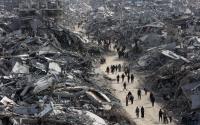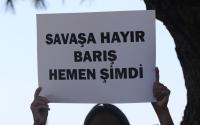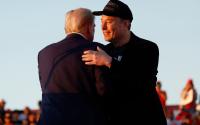Paul Rogers8.4.2003
The pace of events has quickened in the last, intensive days of combat in the Iraq war. The focus of world and media attention is on the fate of the regime in its Baghdad heartland. But a sense of the impact of war on the country and region as a whole is also essential at this crucial stage.
For a few hours on Saturday 5 April, it began to look as though the war was coming to an end. Reports from US military headquarters in Qatar suggested that substantial numbers of tanks and armoured personnel carriers had driven right in to the centre of Baghdad and were taking up positions to occupy significant parts of the city.
The advance built on several days of intense bombing of Iraqi army positions to the south of Baghdad that appeared to have destroyed as many as three Iraqi divisions with the loss of several thousand troops. It also followed the rapid occupation of the main civil airport on 4 April. These developments together seemed to indicate that resistance was crumbling and that the Iraqi regime was on the point of collapse.
By the morning of Sunday 6 April, an imminent end to the war seemed less likely. US forces had certainly been able to use their extraordinary firepower in the open country south of Baghdad, and they had almost certainly killed and injured very many Iraqi soldiers. Even so, their initial attack on Baghdad represented more of a major armoured reconnaissance than the final termination of the regime.
This was followed by the even more substantial US incursion into the centre of Baghdad on 7-8 April. Its aim is clearly to take over and destroy the physical centres of power of the regime; it is being pursued with the use of massive force. This might bring the main phase of the war to a rapid end and would undoubtedly save thousands of lives. It would not necessarily mean an end to all conflict, as other parts of Iraq might still have militia willing to fight on.
Even such an immediate end, though, is by no means assured, and any attempt to assess what is now happening has to take into account three significant factors: American military superiority, Iraqi military and civilian losses, and the responses of regime forces to the invasion of their country.
The US military in command
The first factor to register is that the US forces have overwhelming superiority in terms of technology and firepower. There is complete air supremacy, the weapons capacity of B-52 and B1B planes is enormous and the army and Marine Corps are equipped with weapons that are three or more decades ahead of those of the Iraqis. After twelve years of sanctions, Iraqi forces are nowhere near the level they were in the 1991 war. Moreover, the American forces are able to combine near real-time intelligence-gathering with a huge array of precision-guided weapons, and they can also call upon an inventory of area-impact munitions (see the article The myth of a clean war in this series).
It is this category of weapons, combined with the mass use of artillery that has killed so many Iraqi soldiers and also many civilians. There has been some recent controversy over the use of cluster bombs, but it is commonly forgotten that a single MLRS missile launcher can deliver the destructive power of forty cluster bombs. These weapons are so powerful that they are sometimes referred to as conventional weapons of mass destruction, and are being used repeatedly by US forces in the field.
In the case of the Massive Ordnance Air Burst (MOAB) weapon, Aviation Week (17 March 2003) reported that its test launch in Florida on 11 March produced a detonation audible, and ‘mushroom cloud’ visible, from almost fifty kilometres away; and quoted an air force official that “(a)t least a dozen MOABs are being rushed through production for delivery to units that could use them to bomb Republican Guard troops”.
Iraqi losses
Although the Saddam Hussein regime has given frequent details of civilian casualties, it has not tried to report on military casualties. In the last few days, US sources have been more explicit, citing the destruction of up to three Republican Guard divisions in addition to 2-3,000 deaths in the fighting at the airport and in the city. Earlier there were reports of 1,000 Iraqi soldiers being killed around Najaf and British sources estimated that up to 500 were killed on the weekend of 5-6 April in the fighting around Basra.
In the light of these figures, and even assuming that only one in five of the soldiers in a ‘destroyed’ division actually dies, the military losses incurred by Iraqi forces will already run to at least 10,000. In modern war, it is assumed that three people are seriously injured for every person that is killed. This is likely to be the case for the Iraqis, with many of those injured subsequently dying as medical support away from the towns and cities will be extremely limited. Thus, twenty days of war has almost certainly resulted in around 40,000 Iraqi soldiers killed or seriously injured – hardly a clean war.
The civilian losses have been much lower, but are still heading towards 1,000 people killed and perhaps three times as many seriously injured by the end of the second week of war. To take only one major example, the determined US attack on Nasiriya to try and dislodge Fedayeen militia involved sustained bombing over several days that killed around 230 civilians as well as many more military.
There is ample recent evidence from independent sources of the intense difficulties faced by the civilian population in Baghdad and elsewhere. According to the Red Cross, at the height of the 5 April fighting, all the hospitals in Baghdad were under pressure. The al-Yarmouk Hospital, for example, was receiving one hundred casualties per hour. The hospital at al-Mahmudiya, south of the city, was unable to cope with the number of casualties, and the Red Cross was trying to get urgent help to the hospital at Hilla further to the south.
In short, as many as 10,000 soldiers and 1,000 civilians may have been killed and over 30,000 injured in less than three weeks. Such a toll is recognised only at the margins of the western media, but is much more clearly registered across the Middle East – where it is perceived as the killing of Arabs in their thousands by Americans, in the interests of a policy of conquest and occupation.
Iraqi responses
This level of loss must surely mean that the regime is near its end, though here again some caution is necessary. At the start of the war, on 19-20 March, there was an initial assumption that “shock and awe” would bring about immediate regime collapse. Even if that did not happen, Basra was expected to be liberated in two days at most, and US troops were expected to be surrounding Baghdad within five days. Apart from Baghdad, little or no resistance was envisaged.
It has turned out very differently, yet the same kinds of assumptions persist at each phase of the war. While it is obvious that Iraqi forces have no prospect at all of defense against US military power in the field, resistance in towns and cities has been substantial. Basra may now be close to occupation by the British, but this will have taken nearly three weeks instead of two days, and opposition may still lie ahead. Nasiriya and Karbala still have active irregular forces, as do a number of smaller towns; together they are tying down thousands of American troops.
Moreover, the depiction of the Republican Guard is occasionally misleading. In 1991, this eight-division force was the elite group within the Iraqi armed forces, but the regime was concerned about its loyalty in the mid-1990s, reducing it in size and charging it with the perimeter defense of Baghdad and other parts of Iraq. There is little evidence that the Republican Guard was ever assumed to be sufficiently reliable to be allowed into Baghdad in force.
In the period before the war, some experienced analysts were assuming that the Republican Guard would offer virtually no resistance at all, and that the more general components of the Iraqi army would surrender in their tens of thousands. As it turned out, the mass surrenders were far smaller than expected, and the Republican Guard did fight, albeit with huge losses.
The questionable loyalty of these troops in the 1990s meant that the most reliable elements were concentrated in an entirely different set of forces, the Special Republican Guard and other units, including the Fedayeen. These together may number as many as 30,000 people, trained especially in urban warfare and assumed to be markedly loyal to the regime. As far as it is possible to say, these groups have played little part in the war and are available in Baghdad for the defense of the regime.
A hollow victory
The implication of the foregoing analysis is that it is at least possible that the war has some time to run, and that it will involve substantial further loss of life, both military and civilian. While the regime has been severely weakened and might even be close to collapse, it is also likely that US forces will take time in moving into the whole of Baghdad, attempting to bring in up to 20,000 more troops over the next ten days.
The problem for US military commanders is that they are under political pressure from Donald Rumsfeld and others to terminate the regime and end the war quickly. They have the means to do this, in the shape of their overwhelming firepower in pursuit of the defending forces, but the inevitable consequence of that would be much greater numbers of civilians killed and maimed. The current operations in Baghdad do indicate that this is the military policy now being pursued.
A relevant factor here is the popular mood in the Middle East, which is turning ever more strongly against the United States. A protracted war would allow that to develop further, while a sudden escalation of violence by US forces might end the regime more quickly but at the cost of passionate anger across the region in protest at a higher level of casualties.
In the United States, the dominant perception seems to be that the war is already as good as won, and that peace and tranquility will rapidly follow a stunning victory. In reality, whether the war ends soon or drags on, it is likely to prove a hollow victory with a deeply bitter and unstable peace.






